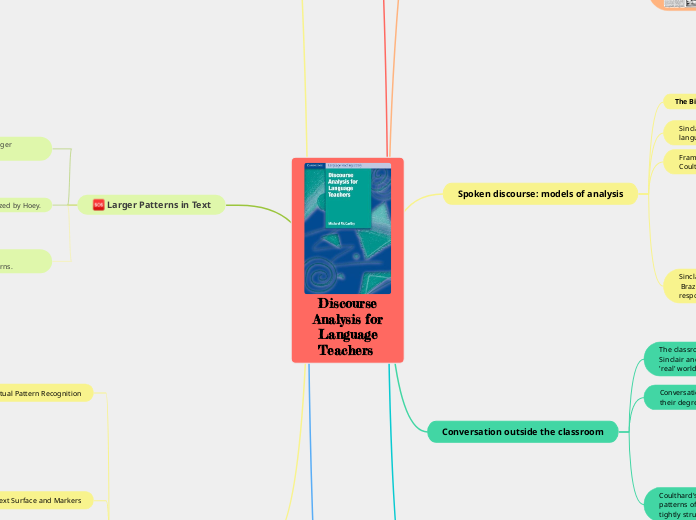It is important to find these simple initiation, response and follow-up movements
Identify where each movement begins and ends and try to find some examples: questions, answers and comments.
Discourse
Analysis for
Language
Teachers
Written discourse
Written discourse can be specifically applied to language teaching.
It presents grammatical regularities how sentence structuring has implications for units such as sentences, paragraphs and for the progression of whole texts.
Most texts show links from one sentence to another in terms of grammatical features such as pronominalization, ellipsis.
It is also possible to create superficial links between clauses and sentences in a text, known as cohesion.
Text and Interpretation
Beaugrande and Dressler are central to reader-centered interpretation.
Procedural approaches emphasize the active role of the reader.
Interpretation depends on the reader and author.
Clause-Relational Approach
• Winter and Hoey's work focuses on interpretive acts between textual segments.
• Logical sequencing and matching are basic categories in this approach.
• Cognitive links create coherence beyond semantic ties.
Example:
Python attacking a boy - reader activates knowledge to make sense.
Text Surface and Markers
Cohesive markers link sentences, pairing related items.
Reading involves the interpretation of ties for a coherent understanding.
Linguistic signals convey semantic and discourse functions.
Textual Pattern Recognition
Segments (phrases, clauses, sentences) have functional relationships.
Reader recognizes patterns in text.
Segments can form patterns like phenomenon-reason, cause-consequence, and instrument-achievement.
Larger Patterns in Text
Signalling devices like subordination and parallelism used to interpret larger patterns.
Problem-solution pattern analyzed by Hoey.
Clause-relational approach extends to larger patterns.
What is discourse analysis
The form and funtion
Fundamental distinction: forms of language and function of discourse.
The situations that we are going to follow will follow different conventions and the factors involved.
Decisions about communicative function cannot be the exclusive domain of grammar or phonology.
Non-inverted declarative form (subject before the verb).
The inversion of the verb and its subject occurs only under restricted conditions in English.
Discourse functions are the forms of language, language teaching.
Relationships between language forms (grammatical, lexical and phonological)
In contrast, discourse analysis is a set of descriptive labels separate from those used by conventional grammarians.
spoken interaction
Different; ways of opening and closing the encounter, role relationships, purposes and environments.
Discourse analysis is not entirely separate from the study of grammar and phonology.
Grammatical and phonological forms examined separately are unreliable indicators of function.
The communicative function cannot be solely the domain of grammar or phonology.
A brief historical overview
The formulation of conversational maxims, along with the emergence of pragmatics, which is the study of meaning in context.
Linguistic philosophers influenced the study of language as social action, reflected in speech act theory and speech act theory.
In 1960, Dell Hymes: sociological perspective with the study of speech in its social sense.
Emergence of semiotics and the French structuralist approach to the study of narrative.
Harris in 1952 spoke of the distribution of linguistic elements in extended texts and the links between the text and its social situation.
They study the language in use:
• written texts of all kinds
• spoken data
Different disciplines emerged in the 60s and 70s, such as linguistics, semiotics, psychology, anthropology and sociology.
It deals with the study of the relationship between language and the contexts in which it is used.
Talk as a social activity
THE TALK
But when the talk is informal and among peers, everyone will have a role to play in coordinating and controlling the discourse
Between professors or between doctor and patient, it is relatively easy to predict who will open and close the talk.
Conversation outside the classroom
Coulthard's model is very useful for analysing patterns of interaction where talk is relatively tightly structured.
Conversations outside classroom settings vary in their degree of structuredness
Mainly in the next areas, discourse analysts have found it necessary to expand and modify the Sinclair-Coulthard model.
Type of speech act labels needed to describe what is occurring.
The functions of the parts of individual moves.
The classroom was a convenient place to start, as Sinclair and Coulthard discovered, but it is not the 'real' world of conversation
Spoken discourse: models of analysis
Sinclair and
Brazil (1982: 49) prefer to talk of initiation, response and follow-up.
Framing move is precisely what Sinclair and Coulthard call the function.
Transaction
The two framing moves, together with the question and answer sequence that falls between them.
However
Framing move and transaction are only labels to attach to certain structural features
Sinclair and Coulthard found a rigid pattern in the language of traditional school classrooms.
The Birmingham model
It is a relatively simple and powerful model which has connections with the study of speech acts.
The scope of discourse analysis
The overall aim is to come to a much better understanding of exactly how natural spoken and written discourse looks and sounds.
Spoken Analysis
Oral debate
Written analysis
recipes
comics
letters
newspaper articles
Speech acts and discourse structures
They are "functions" of oral or written language
Discourse structures
They are based on a dialogue and how the whole text is organized around a specific oral topic.
Speech acts
Acts that seek a specific meaning to convey the message to any kind of text.

